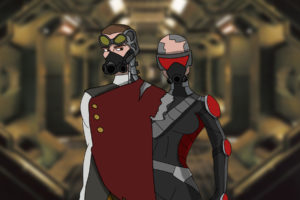Arentian (ah-rehnt-ee-ahn)

Arentians
An Arentian (Ah-rehnt-ee-ahn) was an intelligent life-form from the Arentium (Ah-rehnt-ee-uhm) universe. Technically they were human, not some other race. Some had so many cybernetic parts grafted on to their bodies that they barely resembled a person at all.
Arentium was the oldest of the three major universes. It was billions of years more advanced than Earth and Fabella. However, due to extreme after effects of the Titanic Rebellion, all planetary life was wiped out. The only people left alive resided on the space station known as “the Duat (Doo- aht).”
Drifting throughout the bleak Arentium cosmos in their space station made Arentians sensitive to light. They were perfectly at home in cramped living spaces and acclimated to cooler temperatures. It was so dark in some areas of the space station that some families of Arentians lost their eyesight. This did not make Egypt the best place for them, which was one of the reasons why most of the control ended up with those “gods” in the Egyptian Pantheon who were humans born on Earth.
Extended Lifetime
Just when all hope for the Arentians was nearly extinguished scientists discovered a portal to another universe teeming with life. They travelled through this portal to land on Earth, where they quickly colonized the planet.
Later, it was discovered that time passed faster on Earth than it did in Arentium. A thousand years on Earth was equal to one day in Arentium. Furthermore, because of this cosmic anomaly, anyone who passed through the portal to Arentium would age back to the age they were when they left.
Example:
- Man leaves Arentium at age 18 to go through the portal to Earth.
- Man ages on Earth to 80 years of age.
- Man goes back through the portal to Arentium and automatically ages back to 18.
- Man returns to Earth as an 18 year old.
This cycle blessed Arentians with an extended lifetime. They were not immortal. They could technically live forever, barring any severe life threatening injuries that resulted in death.
Sumerian Pantheon
The first group of Arentian travelers to Earth set up a small colony with the goal of harvesting resources they could bring back to Arentium. Due to their advanced technology, they became known as gods by the primitive Mesopotamian people in the region. The early Arentian pioneers embraced this idea and constructed myths to support this belief system. Many early Arentians assimilated with the native people of Earth and never returned to Arentium.
Egyptian Pantheon
The best known Arentian travelers came from the Egyptian Pantheon. This period saw Arentians wearing masks shaped like animals to make the Egyptian people believe they were gods and goddesses. Myths and legends spread by the Egyptians often involved true accounts of their Arentian overlord’s personal lives. Sometimes details the gods and goddesses preferred nobody know about.
Major Arentian Egyptian Pantheon Characters
Anubis, the jackal masked God of Mummification and keeper of the Book of the Dead.
Bastet, the cat headed Goddess of Protection, was incorporated into the Egyptian Pantheon after Ra adopted her.
Thoth, the ibis headed God of Wisdom, Ra’s son with Tefnut
Major Non-Arentian Egyptian Pantheon Characters
Sekhemet-Hathor a.k.a. “Lilly“, lion headed Goddess of Healing and the Sky. She was welcomed into the Pantheon due to her connections with Nun — the God of Water — and their son Ra; God of the Sun and first King of the Gods.
Tefnut, lion headed Goddess of Moisture, was a time traveler who assimilated with the Arentians early in their history on Earth. She later came back to the Egyptian Pantheon as the goddess “Isis.” Nobody recognized her but Lilly, whom formed a lifelong rivalry with Tefnut. Unbeknownst to her at the time, Tefnut was a magically gifted chupacabra.
